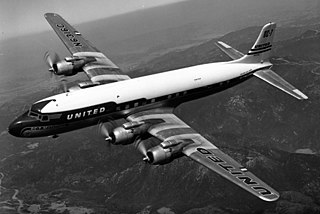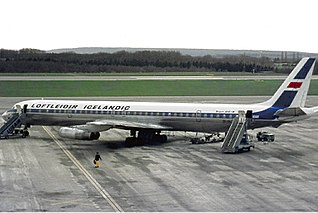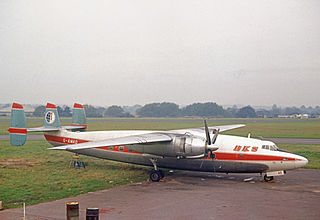
The Douglas DC-7 is an American transport aircraft built by the Douglas Aircraft Company from 1953 to 1958. A derivative of the DC-6, it was the last major piston engine-powered transport made by Douglas, being developed shortly after the earliest jet airliner—the de Havilland Comet—entered service and only a few years before the jet-powered Douglas DC-8 first flew in 1958. Larger numbers of both DC-7B and DC-7C variants were also built.

Caledonian Airways was a wholly private, independent charter airline in the United Kingdom formed in April 1961. It began with a single 104-seat Douglas DC-7C leased from the Belgian flag carrier Sabena. Caledonian grew rapidly over the coming years to become the leading transatlantic "affinity group" charter operator by the end of the decade. During that period, passenger numbers grew from just 8,000 in 1961 to 800,000 in 1970. The latter represented 22.7% of all British non-scheduled passengers. It also became Britain's most consistently profitable and financially most secure independent airline of its era, never failing to make a profit in all its ten years of existence. By the end of 1970, Caledonian operated an all-jet fleet consisting of eleven aircraft and provided employment for over 1,000 workers. At that time, its principal activities included group charters between North America, Europe and the Far East using Boeing 707s, and general charter and inclusive tour (IT) activities in Europe utilising One-Elevens.

Pilot error generally refers to an accident in which an action or decision made by the pilot was the cause or a contributing factor that led to the accident, but also includes the pilot's failure to make a correct decision or take proper action. Errors are intentional actions that fail to achieve their intended outcomes. The Chicago Convention defines the term "accident" as "an occurrence associated with the operation of an aircraft [...] in which [...] a person is fatally or seriously injured [...] except when the injuries are [...] inflicted by other persons." Hence the definition of "pilot error" does not include deliberate crashing.

Loftleiðir Icelandic Airlines Flight 001, was a flight chartered by a Douglas DC-8. The aircraft crashed on 15 November 1978, on approach to the international airport in Colombo, Sri Lanka. The crash killed 8 of the 13 Icelandic crew members, 5 reserve crew members, and 170 Muslim pilgrims from South Borneo out of a total of 262 passengers and crew. The official report by Sri Lankan authorities determined the probable cause of the crash to be failure of the crew to conform to approach procedures; however, American and Icelandic authorities claimed faulty equipment at the airport and air traffic control error as the reasons for the crash.

Armavia Flight 967 was a scheduled international passenger flight operated by Armavia from Zvartnots International Airport, Zvarnots in Armenia to Sochi, a Black Sea coastal resort city in Russia. On 3 May 2006, the aircraft operating the route, an Airbus A320-200, crashed into the sea while attempting a go-around following its first approach to Sochi airport; all 113 aboard were killed. The accident was the first major commercial airline crash in 2006. It was Armavia's only fatal crash during the airline's existence.

Douala International Airport is an international airport located in Douala, the largest city in Cameroon and the capital of Cameroon's Littoral Region. With its 4 terminals and an average of 1.5 million passengers and 50,000 tonnes of freight per year, it is the country's busiest airport. The airport is managed and partly owned (34%) by the company Aeroport du Cameroon (ADC) which also manages all other 13 airports on Cameroonian soil.

Kenya Airways Flight 507 was a scheduled Abidjan–Douala–Nairobi passenger service, operated by Kenya Airways. On 5 May 2007, the Boeing 737–800 aircraft serving the flight crashed in the initial stage of its second leg, immediately after takeoff from Douala International Airport in Cameroon.

Air Moorea Flight 1121 was a de Havilland Canada DHC-6 Twin Otter which crashed into the ocean shortly after takeoff from Moorea Airport on Moorea Island in French Polynesia on 9 August 2007, killing all 20 people on board.

Nigeria Airways Flight 2120 was a chartered passenger flight from Jeddah, Saudi Arabia, to Sokoto, Nigeria, on 11 July 1991, which caught fire shortly after takeoff from King Abdulaziz International Airport and crashed while attempting to return for an emergency landing, killing all 247 passengers and 14 crew members on board. The investigation traced the fire to underinflated tires which overheated and burst during takeoff, and subsequently discovered that a project manager had prevented those tires from being replaced because the aircraft was behind schedule. The aircraft was a Douglas DC-8 operated by Nationair Canada for Nigeria Airways. Flight 2120 is the deadliest accident involving a DC-8 and the deadliest aviation disaster involving a Canadian airline.

Spanair Flight 5022 or (JK5022/JKK5022) was a scheduled domestic passenger flight from Barcelona–El Prat Airport to Gran Canaria Airport, Spain, with a stopover in Madrid–Barajas Airport that crashed just after take-off from runway 36L at Madrid-Barajas Airport to Gran Canaria Airport at 14:24 CEST (12:24 UTC) on 20 August 2008. The aircraft was a McDonnell Douglas MD-82, registration EC-HFP. Of the 172 passengers and crew on board, 154 died and 18 survived.

Colgan Air Flight 9446 was a repositioning flight operated by Colgan Air for US Airways Express. On August 26, 2003, the Beechcraft 1900D crashed into water 300 feet (91 m) offshore from Yarmouth, Massachusetts, shortly after taking off from Barnstable Municipal Airport in Hyannis. Both pilots were killed.

On 3 July 1968, BKS Air Transport Flight C.6845, an Airspeed Ambassador registration G-AMAD of BKS Air Transport crashed at Heathrow Airport, damaging two parked Trident airliners as it cartwheeled into the incomplete Heathrow Terminal 1, then under construction. Six of the eight people on board the Ambassador were killed, along with the eight racehorses being transported on it. The crash was blamed on the failure of a flap-operating rod due to metal fatigue, resulting in asymmetrical lift.

On 10 March 1949 a Lockheed Lodestar aircraft became airborne at Coolangatta, Queensland, Australia for a flight to Brisbane. Before reaching a height of 300 feet (90 m) it suddenly pitched nose-up, stalled and crashed onto its belly beyond the end of the airstrip.

Tropical Airways Flight 1301 (TBG1301/M71301) was a domestic short-haul passenger flight, flying from Cap-Haïtien International Airport in Cap-Haïtien, Haiti to the commune of Port-de-Paix which crashed onto a sugarcane field less than 10 minutes after take off on the evening of 24 August 2003. The aircraft was a 19-seater Let L-410 Turbolet carrying 19 passengers and 2 crew. Witnesses stated that the aircraft caught fire during take-off and exploded when it hit the ground. All on board were killed.

Aeroflot Flight 068 was a regularly scheduled passenger flight operated by Aeroflot from Khabarovsk Novy Airport in Khabarovsk Krai to Pulkovo Airport in Saint Petersburg with intermediate stops at Tolmachevo Airport in Ob, Russia, then Koltsovo Airport in Yekaterinburg. On 16 March 1961, the Tupolev Tu-104B operating this flight crashed shortly after take off from Koltsovo Airport due to engine failure. Two crewmembers and 3 passengers along with two people on the ground, perished.















